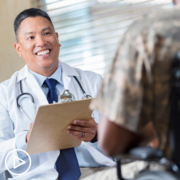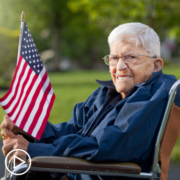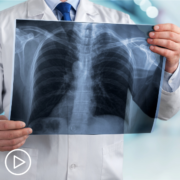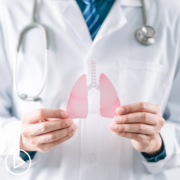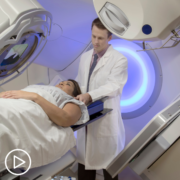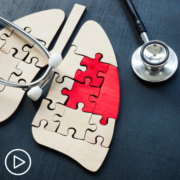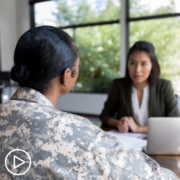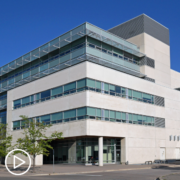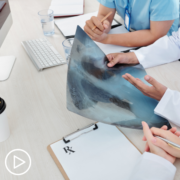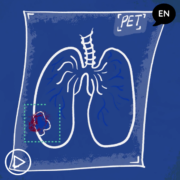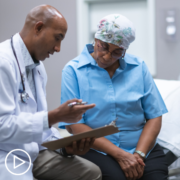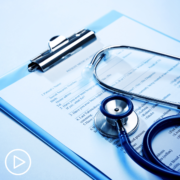Equity in Action | Addressing Biomarker Disparities in Lung Cancer
Equity in Action: Addressing Biomarker Disparities in Lung Cancer from Patient Empowerment Network on Vimeo.
How can biomarker disparities be reduced in lung cancer patients? Experts Dr. Joshua Sabari from NYU Langone and Dr. Eugene Manley from SCHEQ Foundation discuss approaches that are being used for community engagement and further interventions that can be used to reduce disparities.
Download Resource Guide | Descargar guía de recursos
See More from [ACT]IVATED NSCLC Biomarkers
Related Resources:
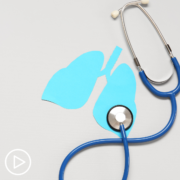
Understanding Non-Small Cell Lung Cancer: Types, Biomarkers, and Treatment Insights |

Navigating Lung Cancer Biomarker Testing | Challenges and Solutions for Timely Access |

|
Transcript:
Lisa Hatfield:
So, Dr. Manley, are there any promising approaches or interventions aimed at reducing biomarker disparities that you’ve currently been exploring or are advocating for?
Dr. Eugene Manley:
I will take several angles on this. One thing is there has to be much more community engagement and involvement and really going to community groups, whether they’re faith-based, whether they’re barbershops, really going out where people are and letting them know about lung cancer, lung cancer disparities, biomarker testing, what you can do. The other way is also going to conferences where there are more diverse scholars that are attending. So a lot of these are STEMM meetings. They may not be specific in lung cancer, but if you can go out there and get the word out about lung cancer and the disparities, then they can go back to their families and talk about, you know, screening and testing and making sure that their family members are aware.
And then, you know, we just published a paper recently that shows the upstream part of biomarker testing is where are we starting at with our cell line? We just did a review of all the lung cancer cell lines. Of over 800 cell lines, majority were European-based. Only 31 cell lines in total were from Black African American populations. None were from Hispanic, none were from Native American, Pacific Islander, none from Alaska Native.
So just think about this. If that is our starting material for all of our biomarker testing and TCGA and databases, then everything we’re developing is on a population that already has great access and outcomes. But they don’t have the greatest disparities. So then you’re getting through doing all these trials, and then you have biomarkers, and you have immunotherapies coming out, and then you’re seeing adverse events in these diverse populations at the end because you don’t have the starting material.
Lisa Hatfield:
And, Dr. Sabari, after hearing Dr. Manley’s comments about that, how do you…or do you know of any approaches or interventions that are aimed at reducing these biomarker disparities? Because maybe they aren’t being acknowledged yet. Maybe they’re only being seen in certain populations.
Dr. Joshua Sabari:
Yeah, I think Dr. Manley hit it on the head. First off, we don’t even know the correct or true numbers for certain mutations in specific patient populations. And I just read an article about patients from Latin America, different rates of EGFR, ALK, and other mutations. You can imagine a study population from Africa, for example. And then obviously studying a population of Black Americans here in the United States as well.
We know that most of the cell lines, most of the data that we’ve had, particularly TCGA (Tumor Cell Genome Atlas) is from a Caucasian or North European patient population. So I think we need to do better in that sense. I think equally as important, are clinical trial enrollment needs to diversify. Again, it’s mostly women. It’s mostly Caucasian women. We have very, very low rates of Hispanic patients enrolled on clinical trials, Blacks enrolled on clinical trials.
So I think we need to do better in that sense. One thing that we’ve really pushed for in academic medicine is to at least report who is being enrolled on trials so that we can understand is this data generalizable to my own clinical practice? And oftentimes if you look at the clinical characteristics of patients enrolled on the trial, it likely does not match what you see in your own practices.
So we need to do better in that sense. So I think the FDA, and especially pharmaceutical companies, are clearly looking to expand and broaden their inclusion criteria and also access to patients so that we can actually have a more diverse patient population that represents our country enrolled on these trials.
Share Your Feedback
Create your own user feedback survey


